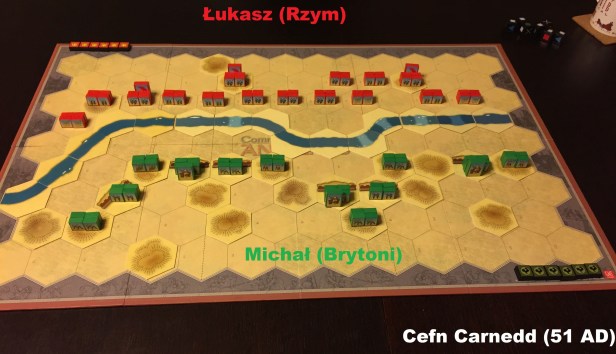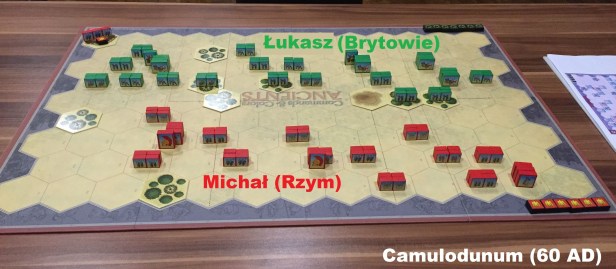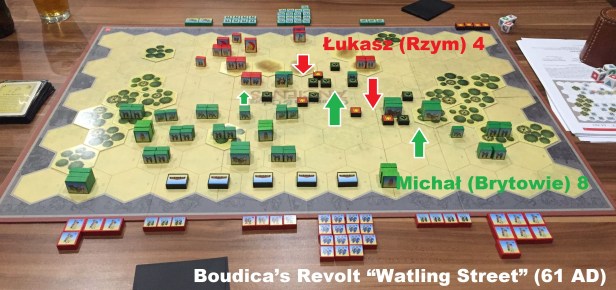I like to play CCA scenarios in logical groups, combining them in mini-campaigns -especially, if they are spread across multiple expansions and C3i publications. Usually I will read about the events, create map to depict the locations of battles and will try to play in one-two sessions all the scenarios, making sure that I am one side in the campaign and my partner – the other. That is my way of playing and I get a lot of satisfactions from such approach – not only pure gaming experience but also a historical insight.
That was the situation with a group of scenarios I called “conquest of Britain” – I actually put here the following positions:
- Medway (43 AD) from Exp3
- Cefn Carnedd (51 AD) from Exp2
- Mona Insulis (60 AD) from C3i #23
- Camulodunum (60 AD) from C3i #23
- Boudica’s Revolt “Watling Street” (61 AD) from Exp4
- Mons Graupius (84 AD) from Exp4
Disclaimer: as you can see there are no Caesar battles here. But rest assured they will be in another campaign I am going to describe soon – Caesar vs. Gauls.
So, we organized two game sessions with my friend Lukasz and played all 6 scenarios. Let us start with the initial three:

One more comment – I took the side of Britons in all scenarios and Lukasz was commanding Roman forces. Let us see how it went!
01. “Medway (43 BC)”
So we started with reasonably large battle from Claudian conquest of Britain:

The main opponents here were Vespasian – future Roman Emperor and Caratacus – key leader of British tribes, who actually managed to defy Romans for over 10 years. The situation on map is interesting, the Medway river is passable only for light units (and you can see them already on the left Roman wing) while heavy legions use a pontoon bridge to slowly cross the river.
Historically, Britons attacked light auxiliary units but legions managed to cross in time to turn the tide of battle. Well, in our game the initial part actually started historically – I attacked green units:

However, the heavy legions were too slow to make a significant difference and – to our surprise – I managed to achieve victory.
02. “Cefn Carnedd (51 AD)”
Eight years passed and Romans are now in nowadays Wales. They have hard nut to crack – Britons are hidden behind river, in hills, with many strong positions built. What is more, they are lead by… Caratacus, who knows very well Roman tactics:

Here I have to admit Lukasz played perfectly – instead of headlong attack, he came close to my barbarians and then showered them with pilum. Unfortunately, it seems that Romans attacked just a little too early – which after counter-charge of Britons (nobody was counting casualties or paid any attention to them) led to marginal victory of the defenders:

Second scenario, and Britons win again. Well, seems it is not fully historically… but we have a lot of fun in those games 🙂
03. “Mona Insulis (60 AD)”
That is one of the most effective scenarios – it depicts attack on a small island just at the northern shores of Wales. That was pretty difficult and horrifying experience for Romans as they faced druids, painted warriors and screaming women – however, that is what you would expect at the place which was the heart of their religion:

It is very, very difficult scenario for Romans – to simulate parlays of Roman forces, they cannot cross river until in their section a units with leader crossed and survived a turn. Of course, that was the key point of my defense – as well as using druids, which give hit in range battle on swords.
In the end I managed to repel attacks in the center and on my right but Lukasz managed to cross in force on the right:

Again, close score. However, due to special rules I cannot recommend that scenario as a really enjoyable one. At this moment we finished our first session – we played 3 scenarios, so far 3 wins for Britons and score in victory banners 19-14 for them.
Couple of weeks later we continued our games, playing scenarios 4-6:

04. “Camulodunum (60 AD)”
So, we started with first of Boudica revolt scenarios. It has an interesting special rule, with small Roman garrison defending desperately in a church (top, let corner) and awaiting the relief from main forces:

Camulodunum (today’s Exeter on Great Britain) was a provincial capital at that time. Harsh treatment and injustice of local roman administration was – as pretty often happened – spark which ignited full-scale revolt of the locals. The relief army not only was helpless in rescuing the besieged Romans but also suffered tremendous losses (80%). The spark turned into fire.
In this scenario I had possibility to lead Romans against Britons and it was a very bitter experience. Despite all my ideas and clever tactics the temple fallen and I was shamed – especially in the center:

Well, our game definitely reflected well the historical events.
05. “Boudica’s Revolt “Watling Street” (61 AD)”
After short change of places, we come back to the initial set-up – with me leading Romans and Lukasz Britons. Boudica revolt is spreading – however, new legions and new commanders arrive from Rome and more competent leadership starts to influence the outcome:

At Walting Street we are witnesses to a large, defensive battle, where Roman forces are estimated at 10-15 thousands while they face ~200 thousands Britons (including women, children, old and sick). Still, the numbers are far from even – it is not surprising that legions takes defensive position at the hills.
Hills, yes. They indeed were good defensive position but I actually took example from Lukasz and our first scenario – I approached legions, stooped 2 hexes away and started to pour tons of arrows and javelins at the enemies. I am not claiming that this was masterful attack but it did the trick – legions descended from hills only to be swarmed by my numerous forces:

Ups, it seems that Boudica revolt did not finish at Walting Street…
06. “Mons Graupius (84 AD)”
Now we are 25 years later and history takes us to the northern Scotland – to Caledonia. Gnaeus Julius Agricola – one of the best Roman generals – subdue all the tribes except the fierce Caledonians. He managed to maneuver them into a pitched battle, which was supposed to solidify the Roman hold on this area for centuries:

The battle and set-up looks very balanced – and they really are! Romans have possibility to use heavy legions but need more points there – and Lukasz decided (historically) to battle only with auxiliary forces as well as light infantry / cavalry.

That was a fierce clash, very competitive and actually could finish with the win of either side. In the end – last desperate attack on the right wing – saved the day for Caledonians.
Summary
Well, that was nice and interesting campaign. 6 scenarios, many unexpected outcomes, if I count correctly – only Briton tribes winning. But what was most important – we spent very nice time and had a lot of fun!


nice!!
LikeLike